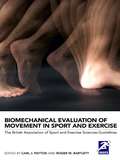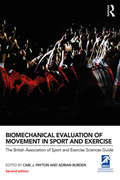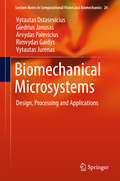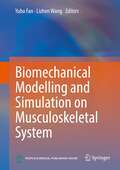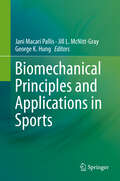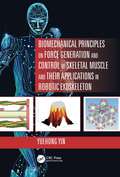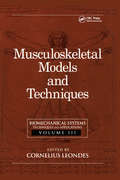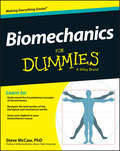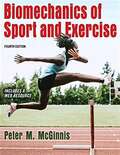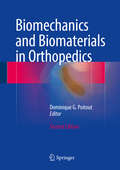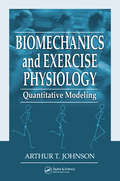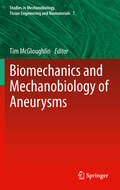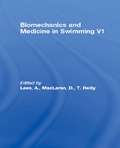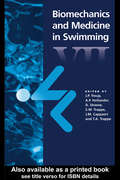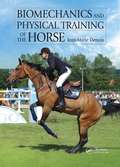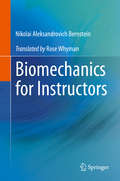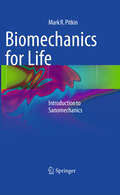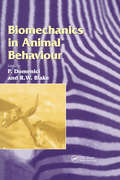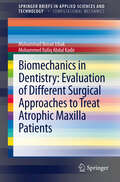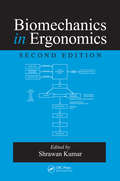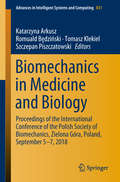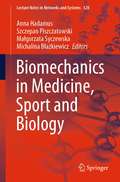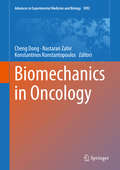- Table View
- List View
Biomechanical Biofeedback Systems and Applications (Human–Computer Interaction Series)
by Anton Kos Anton UmekThis book deals with the topic of biomechanical biofeedback systems and applications that are primarily aimed at motor learning in sports and rehabilitation. It gives a comprehensive tutorial of the concepts, architectures, operation, and exemplary applications of biomechanical biofeedback systems. A special section is dedicated to various constraints in designing biomechanical biofeedback systems. The book also describes the technologies needed for the adequate operation of biofeedback systems, such as motion tracking, communication, processing, and sensor technologies. In regard to technologies, the emphasis is on the assurance of the requirements of the real-time system operation. The application focus is on the usage in sport and rehabilitation, particularly in the field of accelerated motor learning and injury prevention. We include several examples of operational (real-time) biofeedback applications in golf, skiing, and swimming. The book is in the first place intended for the professional audience, researchers, and scientists in the fields connected to the topics of this book.
Biomechanical Evaluation of Movement in Sport and Exercise: The British Association of Sport and Exercise Sciences Guide
by Carl Payton Roger BartlettPublished in association with the British Association of Sport and Exercise Sciences, this is the only up-to-date, practical guide to using the range of biomechanics movement analysis machines, equipment and software available today. It includes detailed explanations of the key theory underlying biomechanics testing, along with advice concerning choice of equipment and how to use your laboratory equipment most effectively. The book covers the following important topics in detail: motion analysis using video and on-line systems measurement of force and pressure in the laboratory and field measurement of power using isokinetic dynamometry electromyography computational simulation and modelling of human movement research methodologies, data processing and data smoothing. Contributors include world leading researchers and pioneers such as Roger Bartlett, Carl Payton, Vasilios (Bill) Baltzopoulos, Adrian Burden, John H. Challis, and computer modelling maestro Fred Yeadon. Biomechanical Evaluation of Movement in Sport and Exercise is a must-have text for all biomechanics laboratories and students undertaking research.
Biomechanical Evaluation of Movement in Sport and Exercise: The British Association of Sport and Exercise Sciences Guide (BASES Sport and Exercise Science)
by Carl J. Payton Adrian BurdenNow in a fully updated and revised new edition, this is still the only up-to-date, practical guide to the use of technology in sport and exercise biomechanics. It includes detailed explanations of the key theory underlying biomechanics testing and measurement, along with advice on choosing equipment and using it effectively. The second edition includes two completely new chapters on qualitative movement analysis and the assessment of movement coordination, and covers every key functional area in the biomechanics curriculum, including: motion analysis using video and on-line systems measurement of force and pressure measurement of torque and power using isokinetic dynamometry electromyography computational simulation and modelling of human movement research methodologies data processing. Published in association with the British Association of Sport and Exercise Sciences (BASES), it includes contributions from world leading researchers and pioneers in the field of sport and exercise biomechanics. Biomechanical Evaluation of Movement in Sport and Exercise is a must-have text for all biomechanics laboratories and for any student undertaking a research project or course in methods, measurement or analysis in biomechanics.
Biomechanical Microsystems: Design, Processing and Applications (Lecture Notes in Computational Vision and Biomechanics #24)
by Vytautas Ostasevicius Giedrius Janusas Arvydas Palevicius Rimvydas Gaidys Vytautas JurenasThis book presents the most important aspects of analysis of dynamical processes taking place on the human body surface. It provides an overview of the major devices that act as a prevention measure to boost a person's motivation for physical activity. A short overview of the most popular MEMS sensors for biomedical applications is given. The development and validation of a multi-level computational model that combines mathematical models of an accelerometer and reduced human body surface tissue is presented. Subsequently, results of finite element analysis are used together with experimental data to evaluate rheological properties of not only human skin but skeletal joints as well. Methodology of development of MOEMS displacement-pressure sensor and adaptation for real-time biological information monitoring, namely "ex vivo" and "in vitro" blood pulse type analysis, is described. Fundamental and conciliatory investigations, achieved knowledge and scientific experience about biologically adaptive multifunctional nanocomposite materials, their properties and synthesis compatibility, periodical microstructures, which may be used in various optical components for modern, productive sensors' formation technologies and their application in medicine, pharmacy industries and environmental monitoring, are presented and analyzed. This book also is aimed at research and development of vibrational energy harvester, which would convert ambient kinetic energy into electrical energy by means of the impact-type piezoelectric transducer. The book proposes possible prototypes of devices for non-invasive real-time artery pulse measurements and micro energy harvesting.
Biomechanical Modelling and Simulation on Musculoskeletal System
by Yubo Fan Lizhen WangThe book involves the basic principles, methods, anatomy and other knowledge for modelling and simulation of the musculoskeletal system. In addition, abundant examples are presented in detail to help readers easily learn the principles and methods of modelling and simulation. These examples include the impact injury and clinical application of the modelling of bone and muscle. In terms of impact injury, the book introduces the biomechanical simulation of impact injury in head, spine, ankle, knee, eyeball and many other parts. With regard to clinical application, it explores the optimization of orthopaedic surgery and design of orthopaedic implants. Readers will find this is a highly informative and carefully presented book, introducing not only the biomechanical principles in the musculoskeletal system, but also the application abilities of modelling and simulation on the musculoskeletal system.
Biomechanical Principles and Applications in Sports
by Jani Macari Pallis Jill L. McNitt-Gray George K. HungThis book provides an overview of biomedical applications in sports, including reviews of the current state-of-the art methodologies and research areas. Basic principles with specific case studies from different types of sports as well as suggested student activities and homework problems are included. Equipment design and manufacturing, quantitative evaluation methods, and sports medicine are given special focus. Biomechanical Principles and Applications in Sports can be used as a textbook in a sports technology or sports engineering program, and is also ideal for graduate students and researchers in biomedical engineering, physics, and sports physiology. It can also serve as a useful reference for professional athletes and coaches interested in gaining a deeper understanding of biomechanics and exercise physiology to improve athletic performance.
Biomechanical Principles on Force Generation and Control of Skeletal Muscle and their Applications in Robotic Exoskeleton (Advances in Systems Science and Engineering (ASSE))
by Yuehong YinThis book systematically introduces the bionic nature of force sensing and control, the biomechanical principle on mechanism of force generation and control of skeletal muscle, and related applications in robotic exoskeleton. The book focuses on three main aspects: muscle force generation principle and biomechanical model, exoskeleton robot technology based on skeletal muscle biomechanical model, and SMA-based bionic skeletal muscle technology. This comprehensive and in-depth book presents the author's research experience and achievements of many years to readers in an effort to promote academic exchanges in this field. About the Author Yuehong Yin received his B.E. , M.S. and Ph.D. degrees from Nanjing University of Aeronautics and Astronautics, Nanjing, in 1990, 1995 and 1997, respectively, all in mechanical engineering. From December 1997 to December 1999, he was a Postdoctoral Fellow with Zhejiang University, Hangzhou, China, where he became an Associate Professor in July 1999. Since December 1999, he has been with the Robotics Institute, Shanghai Jiao Tong University, Shanghai, China, where he became a Professor and a Tenure Professor in December 2005 and January 2016, respectively. His research interests include robotics, force control, exoskeleton robot, molecular motor, artificial limb, robotic assembly, reconfigurable assembly system, and augmented reality. Dr. Yin is a fellow of the International Academy of Production Engineering (CIRP).
Biomechanical Systems: Techniques and Applications, Volume III: Musculoskeletal Models and Techniques
by Cornelius LeondesBecause of developments in powerful computer technology, computational techniques, advances in a wide spectrum of diverse technologies, and other advances coupled with cross disciplinary pursuits between technology and its greatly significant applied implications in human body processes, the field of biomechanics is evolving as a broadly significant area. This Third Volume presents the advances in widely diverse areas with significant implications for human betterment that occur continuously at a high rate. These include dynamics of musculo-skeletal systems; mechanics of hard and soft tissues; mechanics of muscle; mechanics of bone remodeling; mechanics of implant-tissue interfaces; cardiovascular and respiratory biomechanics; mechanics of blood flow, air flow, flow-prosthesis interfaces; mechanics of impact; dynamics of man machine interaction; and numerous other areas. The great breadth and depth of the field of biomechanics on the international scene requires at least four volumes for adequate treatment. These four volumes constitute a well integrated set that can be utilized as individual volumes. They provide a substantively significant and rather comprehensive, in-depth treatment of biomechanic systems and techniques that is most surely unique on the international scene.
Biomechanics
by Cees Oomens Marcel Brekelmans Frank BaaijensThis is the first textbook to integrates both general and specific topics, theoretical background and biomedical engineering applications, as well as analytical and numerical approaches. This quantitative approach integrates the classical concepts of mechanics and computational modelling techniques, in a logical progression through a wide range of fundamental biomechanics principles. Online MATLAB-based software along with examples and problems using biomedical applications will motivate undergraduate biomedical engineering students to practise and test their skills. The book covers topics such as kinematics, equilibrium, stresses and strains, and also focuses on large deformations and rotations and non-linear constitutive equations, including visco-elastic behaviour and the behaviour of long slender fibre-like structures. This is the definitive textbook for students.
Biomechanics For Dummies
by Steve MccawA thorough explanation of the tenets of biomechanicsAt once a basic and applied science, biomechanics focuses on the mechanical cause-effect relationships that determine the motions of living organisms. Biomechanics for Dummies examines the relationship between biological and mechanical worlds. It clarifies a vital topic for students of biomechanics who work in a variety of fields, including biological sciences, exercise and sports science, health sciences, ergonomics and human factors, and engineering and applied science. Following the path of a traditional introductory course, Biomechanics for Dummies covers the terminology and fundamentals of biomechanics, bone, joint, and muscle composition and function, motion analysis and control, kinematics and kinetics, fluid mechanics, stress and strain, applications of biomechanics, and black and white medical illustrations.Offers insights and expertise in biomechanics to provide an easy-to-follow, jargon-free guide to the subjectProvides students who major in kinesiology, neuroscience, biomedical engineering, mechanical engineering, occupational therapy, physical therapy, physical education, nutritional science, and many other subjects with a basic knowledge of biomechanicsStudents and self-motivated learners interested in biological, applied, exercise, sports, and health sciences should not be without this accessible guide to the fundamentals.
Biomechanics Of Sport And Exercise
by Peter M. McGinnisA standout among introductory biomechanics texts, Biomechanics of Sport and Exercise, Fourth Edition With Web Resource, takes a unique approach to introducing exercise and sport biomechanics. Using simple terms, the book presents mechanics before functional anatomy, helping students first understand external forces and their effects on motion; then explores how the musculoskeletal system responds and generates its own internal forces to maintain position; and finally shows how to apply biomechanical principles to analyze movement and ultimately improve performance. The fourth edition expands its commitment to enabling students to discover the principles of biomechanics through observation. Easy-to-understand experiments are presented for students to try in the classroom or on their own. Sample problem sidebars guide students through choosing the appropriate equation to determine the forces acting or motion occurring in a specific scenario and then helps them solve the equation. This practical approach—combining clear illustrations, sample calculations, and encouragement for active learning—helps students develop a deeper understanding of the underlying mechanical concepts. In addition to careful updates throughout the book, other new enhancements in the fourth edition include the following: New content explores the technologies and devices available to coaches, athletes, and the general public to measure aspects of athletes’ movements. New full-color art and diagrams enhance the text and help students visualize mechanics in real-world scenarios. Explanations of the equations used in the text make the content more accessible to students. New concept application boxes provide deeper analysis of the field use of biomechanics, with topics such as the Magnus effect in baseball pitching, the wetsuit effect in triathlons, power output in cycling, centripetal acceleration when running a curve, and the work-energy principles in modern shot putting. Other learning aids include bold key terms, chapter objectives, and a guide to key equations and abbreviations. The chapters include a total of 18 sample problems that students can solve using a step-by-step process. A companion web resource offers additional review questions and problem sets. Biomechanics of Sport and Exercise, Fourth Edition, introduces the biomechanics of human movement in a clear and concise manner while promoting an active, engaged learning experience. Students will discover the principles of mechanics for themselves, resulting in a strong understanding of the subject matter.
Biomechanics and Biomaterials in Orthopedics
by Dominique G. PoitoutWiththe constant evolution of implant technology, and improvement in the productionof allograft and bone substitutes, the armamentarium of the orthopaedic surgeonhas significantly expanded. In particular, the recent involvement ofnanotechnologies opens up the possibilities of new approaches in theinteractive interfaces of implants. With many important developments occurringsince the first edition of this well-received book, this updated resource informsorthopaedic practitioners on awide range of biomechanical advances in one completereference guide. Biomechanics and Biomaterials in Orthopedics,2nd edition compilesthe most prominent work in the discipline to offer newly-qualified orthopedicsurgeons a summary of the fundamental skills that they will need to apply intheir day-to-day work, while also updating the knowledge of experienced surgeons. This bookcovers both basic concepts concerning biomaterials and biomechanics as well astheir clinical application and the experience from everyday practical use. Thisbook will be of great value to specialists in orthopedics and traumatology,while also providing an important basis for graduate and postgraduate learning.
Biomechanics and Exercise Physiology: Quantitative Modeling
by Arthur T. JohnsonWhether you are a bioengineer designing prosthetics, an aerospace scientist involved in life support, a kinesiologist training athletes, or an occupational physician prescribing an exercise regimen, you need the latest edition of Biomechanics and Exercise Physiology: Quantitative Modeling. Using numerous worked examples to demonstrate what and when
Biomechanics and Mechanobiology of Aneurysms (Studies in Mechanobiology, Tissue Engineering and Biomaterials #7)
by Tim McgloughlinCardiovascular disease is the leading cause of morbidity and premature death of modern era medicine. It is estimated that approximately 81 million people in the United States (US) currently have one or more of the many forms of cardiovascular disease, resulting in 1 in every 2.8 deaths, or 900,000 deaths per year. 40% of all deaths in Europe are a result of cardiovascular disease in people under the age of 75. Aneurysms form a significant portion of these cardiovascular related deaths and are defined as a permanent and irreversible localised dilation of a blood vessel greater than 50% of its normal diameter. Although aneurysms can form in any blood vessel, the more lethal aneurysms develop in the cranial arteries, and in the thoracic aorta and abdominal aorta. Frequently aneurysms are undetected and if left untreated may eventually expand until rupture with very high levels of morbidity and mortality. The biomechanics and mechanobiology of aneursymal diseases are not fully understood and this monograph aims to provide new insights into aneurysm aetiology and behavior based on the most recent biomechanics research related to this important topic. The contributors to this volume bring together a unique blend of expertise in experimental, computational and tissue biomechanics relating to aneurysm behavior and enable the reader to gain a fresh understanding of key factors influencing aneurysm behavior and treatment. Biological risk factors such as tobacco smoking, sex, age, hypertension, family history and mechanobiological risk factors such as aneurysm geometry and shape as well as mechanical properties of the diseased tissues are considered in detail as are many of the diagnostic and treatment options.
Biomechanics and Medicine in Swimming V1
by A. Lees T. Reilly D. MacLarenThe International Symposium on Biomechanics and Medicine in Swimming, held every four years under the aegis of the International Society of Biomechanics and the World Commission of Sports Biomechanics, provides a forum in which research related to swimming is reported and problems that confront swimming practitioners are debated. This volume contains the papers presented at the sixth symposium. The keynote addresses covered lactate metabolism, performance determining factors and the analysis of sprint swimming. The contributed papers range widely across sports science, coaching and training and sports medicine.
Biomechanics and Medicine in Swimming VII
by A.P. Hollander D. Strass J. TroupFollowing on from the successful Biomechanics and Medicine in Swimming VI proceedings which covered the conference held in Liverpool, this book contains all twelve of the keynote addresses and selected, edited and revised papers presented at the Swimming Science VII conference in Atlanta. Leading international experts have contributed state-of-the-art research on the subject.
Biomechanics and Physical Training of the Horse
by Jean-Marie DenoixEffective horse trainers strive to improve the performance of their horses while preserving the integrity of the musculoskeletal apparatus. Biomechanics and Physical Training of the Horse supplies an anatomical and functional overview of the topic, enabling trainers to optimize the different exercises their horses undergo during training and compet
Biomechanics for Instructors
by Nikolai Aleksandrovich BernsteinThis book comprises a series of lectures given by celebrated Soviet neurophysiologist Nikolai Alexandrovich Bernstein in Moscow in 1925 and first published in Russian in 1926. Bernstein’s groundbreaking work, which has had a significant influence on the development of neuroscience, movement studies, and other fields of study in Russia, Eastern Europe, and the West, was suppressed during Stalin’s regime. At the time of its publication, Biomechanics for Instructors was a significant resource for teachers, with its descriptions of the movement of joints and degrees of freedom, illustrations of how to calculate the work capacity of muscles with bones acting as levers, the role of the central nervous system in movement, and more. Though the terminologies and methods have changed and been updated as research and technologies have progressed, the book remains a valuable introduction for those interested in Bernstein’s work more generally, and to those involved in the study of biomechanics. This book is also of interest to historians and philosophers of neuroscience, as well as those involved in movement studies in both the scientific and artistic domains, and to physiotherapists and those involved in sports research and practice.
Biomechanics for Life: Introduction to Sanomechanics
by Mark R. PitkinThe reader will find in this book a new approach to improving health. The author has called this approach "sanomechanics," combining the Latin sanus (healthy, sound) and mechanicus (science of the motion of bodies subjected to forces). The focus of sanomechanics is on exercising with an understanding of the biomechanical consequences of the actions. This understanding is based on the author's theory of the floating skeleton, which postulates a hydraulic connection of synovial joints. The theory explains the greater or lesser success of any exercise utilizing the ability of the human skeleton to absorb and transform forces and moments from the body segments and the environment. This ability vanishes with age and illnesses, and the deeper our understanding of the nature of skeletal functioning is, the better we shall be able to improve, protect, and prolong the skeleton's health.
Biomechanics in Animal Behaviour
by P. DOMENICI; R.W. BLAKEBiomechanics in Animal Behaviour offers a unique approach by integrating fully the fields of animal behaviour and biomechanics. It demonstrates how an understanding of biomechanical issues is an important part of evaluating and predicting animal behaviour. The book examines how behaviour is determined and/or constrained by biomechanical variables such as hydrodynamics, aerodynamics, kinematics, and the mechanical properties of biomaterials.
Biomechanics in Dentistry: Evaluation Of Different Surgical Approaches To Treat Atrophic Maxilla Patients (SpringerBriefs in Applied Sciences and Technology)
by Mohammed Rafiq Abdul Kadir Muhammad Ikman IshakThis book shows computational finite element simulations to analyse the strength of implant anchorage for intrasinus and extramaxillary approaches under various occlusal loading locations and directions. Three-dimensional model of the craniofacial area surrounding the region of interest, soft tissue and framework are developed using computed tomography image datasets. The zygomatic and standard dental implants are modeled using a conventional computer-aided design software and placed at the appropriate location. Material properties are assigned appropriately for the cortical, cancellous bones and implants with Masseter forces applied at the zygomatic arch and occlusal loadings applied on the framework surface.
Biomechanics in Ergonomics
by Shrawan KumarSafety or comfort? Can you truly have one without the other? Is it feasible to have both? Although by no means the only factor, a deep understanding of biomechanics plays a leading role in the design of work and workplaces that are both pain and injury free. Standing firmly on the foundation built by the previous edition, the second edition of Biom
Biomechanics in Medicine and Biology: Proceedings of the International Conference of the Polish Society of Biomechanics, Zielona Góra, Poland, September 5-7, 2018 (Advances in Intelligent Systems and Computing #831)
by Katarzyna Arkusz Romuald Będziński Tomasz Klekiel Szczepan PiszczatowskiThis book presents the proceedings of the “International Conference of the Polish Society of Biomechanics – BIOMECHANICS 2018” held in Zielona Góra, Poland from September 5 to 7, 2018, and discusses recent research on innovations in biomechanics.It includes a collection of selected papers in all key areas of biomechanics, including cellular, molecular, neuro and musculoskeletal biomechanics, as well as sport, clinical and rehabilitation biomechanics. These themes are extremely important in the development of engineering concepts and methods to provide new medical solutions, especially in the context of an ageing population.Presenting the latest technical advances and research methods used in clinical biomechanics, this book is of interest to scientists as well as junior researchers and students of interdisciplinary fields of engineering, medical, and sports sciences.
Biomechanics in Medicine, Sport and Biology (Lecture Notes in Networks and Systems #328)
by Szczepan Piszczatowski Anna Hadamus Małgorzata Syczewska Michalina BłażkiewiczThis book contains fourteen chapters dealing with various aspects of the biomechanics of today. The topics covered are glimpses of what modern biomechanics can offer scientists, students, and the general public. We hope this book can be inspiring, helpful, and interesting for many readers who are not necessarily concerned with biomechanics daily.
Biomechanics in Oncology (Advances in Experimental Medicine and Biology #1092)
by Cheng Dong Nastaran Zahir Konstantinos KonstantopoulosThis book covers multi-scale biomechanics for oncology, ranging from cells and tissues to whole organ. Topics covered include, but not limited to, biomaterials in mechano-oncology, non-invasive imaging techniques, mechanical models of cell migration, cancer cell mechanics, and platelet-based drug delivery for cancer applications. This is an ideal book for graduate students, biomedical engineers, and researchers in the field of mechanobiology and oncology.This book also:Describes how mechanical properties of cancer cells, the extracellular matrix, tumor microenvironment and immuno-editing, and fluid flow dynamics contribute to tumor progression and the metastatic processProvides the latest research on non-invasive imaging, including traction force microscopy and brillouin confocal microscopyIncludes insight into NCIs’ role in supporting biomechanics in oncology researchDetails how biomaterials in mechano-oncology can be used as a means to tune materials to study cancer

